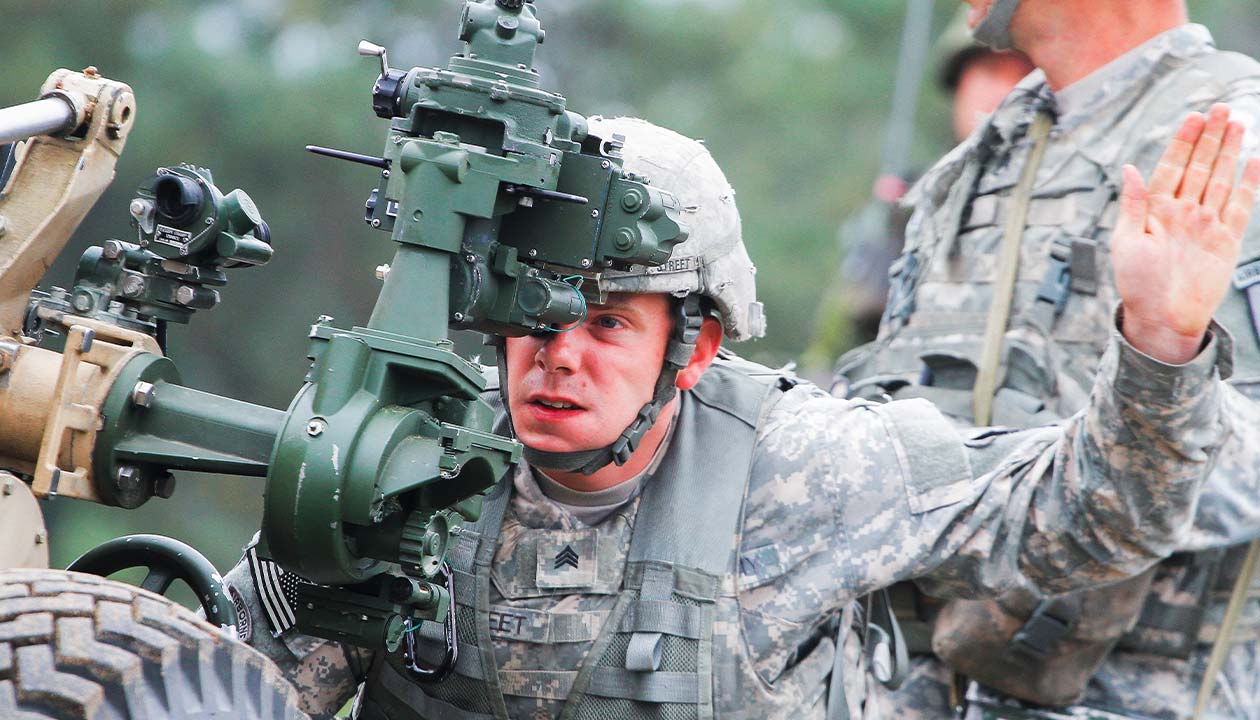The US military service members depend on their gear to undertake missions efficiently while maintaining safety. Over the last few years, lawsuits and complaints revealed some design flaws in the 3M Combat Arms earplugs. These flaws caused veterans and service members to develop tinnitus and hearing damage.
3M’s negligence caused suffering to thousands of service members who dedicated their lives to serving our country.
If you or someone you care about suffers from tinnitus or hearing loss after serving between 2003 and 2015, Join the Many can help you pursue legal action.
History of 3M Combat Arms Earplugs

The US Department of Defense contracted Aearo Technologies to supply combat earplugs for military service members in the late 90s. However, the original earplugs were too big and could not fit in the army-issued carrying case. Service members also had difficulty positioning the helmet correctly.
To resolve this issue, Aearo developed the second version of the Combat Arms Earplug (CAEv2). They were smaller, with a yellow and olive side stuck together.
The dual-ended design aimed to offer better protection and two levels of function. The yellow side allegedly protected the user from high noise levels while allowing them to hear softer sounds, such as commands.
If the sound gets louder, the user could switch to the olive side that supposedly blocks all noise.
However, there were profound defects in the earplugs’ new design. The CAEv2 had a shorter stem that couldn’t reach the inner ear. Prolonged wear also pressed the earplug to the opening of the ear canal, causing the non-inserted side to fold back to the initial position.
The seal created by the earplugs loosened without the person noticing, leaving them exposed and at risk of hearing damage.
The Combat Arms Earplugs Version 2 (CAEv2) were standard issues for US military service members from 2003 to 2015. During the twelve years, the US Logistics Agency supplied CAEv2 to tens of thousands of soldiers serving various regions.
According to the instructions, inserting one end of the earplug into the ear canal creates a tight seal. This seal blocks sounds, protecting the inner ear from hearing damage.
The exterior design claimed to offer more protection for service members. They could hear softer sounds like speech and nearby enemies while remaining protected from louder noises.
The original manufacturer of Combat earplugs was Aearo Technologies. In 2008, 3M acquired Aearo Technologies and proceeded with the exclusive contract. Both companies now face thousands of lawsuits for negligence, misrepresentation, and defective products.
Overview of Research Findings

Most military service members and veterans experience hearing issues. The US Department of Veterans Affairs (VA) cautions that hearing is the most common service-related disability for vets.
In 2019, a tinnitus study on 85,000 active duty service members discovered concerning results. According to the study, approximately 1.8 out of every 1,000 active service members suffered tinnitus in 2001. By 2015, this number was more than five times higher, with 6.8 out of every 1,000 active members having tinnitus.
The US military has strict guidelines for companies that supply products for a particular use. They must undergo rigorous testing to ensure they function and protect the user in the field.
Before distributing CAEv2, Aearo Technologies needed proof that the earplugs met military standards.
They indicated that the earplugs protected users from impulse sounds and noises like firearms. They also stated that users could hear standard speech and commands on active battlefields.
However, the military was unaware that Aearo’s internal tests did not achieve the required ratings. The tests showed mixed results if the earplugs were not in the correct position or adequately fitted.
According to Aearo, the yellow side had a Noise Reduction Rating (NRR) of 0, while the olive end had an NRR of 22. However, the internal tests showed that the actual NRR for the yellow side was -2 and 10.9 for the olive end.
This raises concern for service members on active duty. A negative -2 NRR means the earplugs amplified the sound instead of reducing it.
The CAEv2 earplugs could only achieve 22 NRR if they were a perfect fit for the ear canal. However, the defects affected this ability to fit, causing the seal to loosen and become ineffective. During battlefield sounds and explosions, the noise bypassed the earplugs and into the ear canal.
The military also required the packaging to have clear instructions on using and handling the earplugs correctly. After 3M purchased Aearo, they stopped providing adequate fitting instructions in the packaging. They failed to inform the Army National Guard and the military about the changes. Instead, they directed the users to insert the earplugs in the ear canal as usual.
These instructions were insufficient, so most service members didn’t know how to insert CAEv2 correctly. The improper use increased the risk of loosening, causing inner ear damage and eventual hearing loss in most US veterans.
The US Department of Justice highlighted that 3M was aware of the design flaws from 2000 because the earplugs did not pass product safety tests. They continued supplying the defective earplugs without disclosing the issues or providing warnings.
The military relied on 3M’s earplugs to protect brave soldiers from hearing damage, and the earplugs did the opposite. Service members had no other ear protection alternatives besides faulty earplugs for over a decade.
In recent legal developments, a federal court judge, Judge Rodgers, dismissed certain claims related to the case. The court also approved a settlement agreement, with a designated settlement data administrator overseeing the distribution of funds. Rumors about additional settlements and ongoing discussions continue to circulate, raising questions about the overall impact on affected individuals. The involvement of law firms, securities and exchange commission scrutiny, and the plaintiff census forms have become integral aspects of this complex litigation.
Recalls

These defective earplugs were standard-issue for most military branches for about twelve years. 3M voluntarily ceased to produce and distribute the CAEv2 in 2015, but there were no official recalls.
Some service members may still use them to date, unaware of the potential risk they carry on active battlefields or during training. Unfortunately, nearly 50% of returning service members and veterans have some hearing loss.
General Physician Sentiments

Most military personnel get exposed to unsafe noise levels for extended periods. The noise level from weapons systems like howitzers, rockets, rifles, and handguns varies in intensity.
For instance, an M16 rifle produces 157 dBP (peak unweighted decibels), while a howitzer generates 183 dBP.
Regular exposure to such levels without adequate ear protection can cause hearing loss. It also magnifies the effects and symptoms of PTSD. Hasanat Alamgir and fellow researchers conducted Military Medical Research on veterans. They shared some insights into the connection between PTSD and hearing issues.
They noted that noise-induced hearing injury and impairment combined with PTSD significantly affected service members’ and veterans’ quality of life. Most people eventually develop depression, anxiety, and other mental health disorders.
In 2015, J. Hu and colleagues published a study about veterans and mental health in the International Journal of Otolaryngology. The survey of 91 veterans with tinnitus showed that 79.1% had anxiety, 59.3% suffered from depression, and 58.2% had both.
Service members have a higher risk of PTSD because tinnitus is often stressful, and hearing loss has an isolating effect. Both conditions can make PTSD symptoms like sleep disturbances, anxiety, depression, and obsession more pronounced.
Brief Lawsuit History

Aearo Technologies was the original manufacturer of the defective earplugs. However, 3M also became liable for the earplugs before and after the 2008 sale.
The lawsuit avalanche against Aearo Technologies and 3M started in 2016 when a competitor filed a whistleblower lawsuit against 3M. In the lawsuit, Moldex-Metric Inc. claimed that 3M defrauded the US military by knowingly distributing defective earplugs.
Thousands of service members suffered tinnitus and significant hearing loss as a result.
Moldex-Metric Inc. leveraged the False Claims Act (FCA), arguing that 3M was aware of the defects since 200 but sold the earplugs anyway. They did not correct the design flaws or warn the military or government about the risks.
This ignorance exposed hundreds of thousands of service members to hearing damage and related issues. Although 3M did not admit wrongdoing, they agreed to settle with the Department of Justice for $9,1000,000 in July 2018.
This resolution with the Department of Justice paved the way for the thousands of lawsuits against 3M that followed. Over 230,000 veterans and military service members filed lawsuits. They claimed the defective earplugs caused their tinnitus and hearing problems.
Due to the large number of 3M earplug lawsuits, the federal court system merged them into a Multi-District Litigation (MDL No. 2885) in 2019. In fact, the 3M earplug MDL has the highest number of cases in US history.
An MDL differs from a class action lawsuit because the cases remain independent. If the MDL ends with a settlement, every participant gets a percentage of the amount, depending on their circumstances.
Presenting the cases before one judge makes the litigation process easier to manage and faster. You probably came across bellwether trials regarding the 3M earplug lawsuits. These sample trials provide guidelines for the possible outcomes of future litigations. Bellwether trials only take place in large multidistrict litigations (MDLs).
Both sides can evaluate whether it’s best to agree to a settlement or proceed to trial. Although the Bellwether trials are tests, the rulings and settlements are valid.
Notable Settlements in 3M Earplug Lawsuits

The first bellwether trial ended in May 2021, where a Federal Court jury awarded 7,100,000 to three service members for hearing loss. Each person received $2,100,00 in punitive damages and $830,500 in compensatory damages.
In June 2021, a Florida jury awarded a soldier $1,700,000 for developing tinnitus due to 3M’s earplugs. In October, a US Army veteran named Brandon Adkins received $8,200,00 million for his hearing loss.
In December 2021, a jury in Florida awarded Theodore Finley, a US Army veteran, $22,500,000. Punitive damages amounted to $15,000,000, while $7,500,000 were compensatory damages.
In January 2022, a Florida jury in Pensacola awarded two army veterans, William Wayman and Ronald Sloan, $110 million. This is the largest settlement yet in the 3M earplugs lawsuits. Each person received punitive damages worth $40 million and compensatory damages of $15 million.
Any veteran or service member who developed tinnitus or hearing loss due to faulty 3M earplugs deserves compensation. Join the Many exists to support anyone pursuing legal action against large corporations, including 3M.
Who Can File a 3M Combat Arms Earplugs Lawsuit?

Most service members are unaware that their hearing problems are due to faulty earplugs. If you served between 2003 and 2015, watch out for common signs of damage.
Tinnitus
- Ringing or buzzing sounds in your ear(s) after leaving noisy environments
- Difficulty hearing things because the background noise sounds overwhelming
- Challenges understanding what people are saying after leaving noisy areas
- Feeling like your ears are full when you leave a noisy or crowded area
You may also experience different levels of hearing loss, including:
Mild Hearing Loss
- Challenges following conversations in noisy areas
- Difficulties hearing consonants
Moderate Hearing Loss
- Failure to understand conversations without an assistive device like a hearing aid
- Difficulties understanding vowels and consonants
Severe Hearing Loss
- Complete inability to understand speech
- Inability to communicate without powerful hearing aids or sign language
If you or your loved one got tinnitus or hearing loss after using CAEv2, Join the Many is ready to listen and help you determine whether you have a valid case.
What Damages Can I Recover from a 3M Earplug Lawsuit?

There’s enough evidence showing 3M was well aware of the risks associated with their defective earplugs. They distributed the CAEv2, knowing thousands of users may suffer from hearing loss.
3M enjoyed large profits for years at the expense of Americans who risk their lives for our country, and it’s time they take responsibility.
If defective 3M earplugs caused you to develop permanent hearing issues, you, too, deserve compensation. You can recover damages such as:
- Medical expenses such as physician fees
- Costs of treatment and prescription medicines
- Pain and suffering
- Emotional damages
- Hearing aids and assistive devices
- Lost wages and benefits
- Disability
- Loss of future earning potential
- Diminished quality of life
You Are Not Powerless; Join the Many
There’s no justification for any service member to suffer from hearing loss due to other people’s negligence. Although filing a lawsuit will not undo the damage, financial compensation will give you the better quality of life you deserve.
Join the Many believes the justice system exists to protect the rights of people like you. We understand that going against established corporations can feel daunting and near impossible.
We dedicate our time and resources to ensure you get fair compensation for your pain and suffering.

